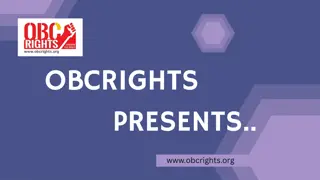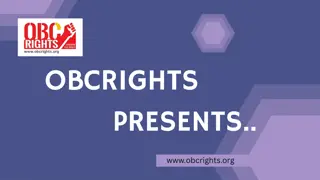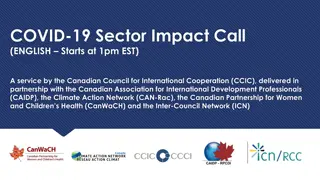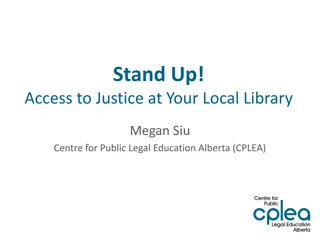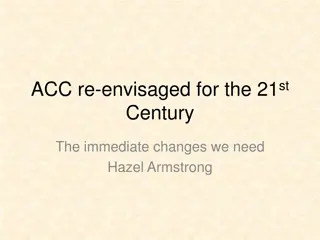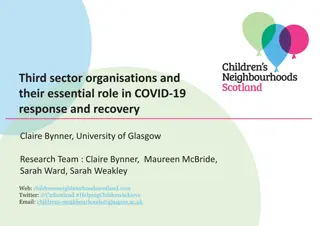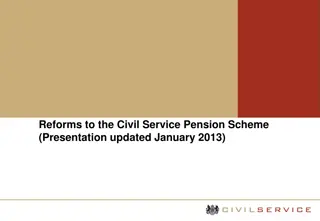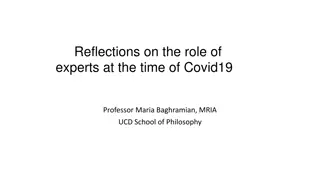Impact of COVID-19 Specialist Advice Service Scheme (CSASS) on Legal Support Sector
The COVID-19 Specialist Advice Service Scheme (CSASS) aimed to support not-for-profit legal advice providers during the pandemic by investing in capacity building and remote service delivery. With grants totaling over £11.59 million, 72 frontline organizations received support to address the increasing demand for legal advice services, particularly in areas outside Greater London. The initiative helped prevent closure of these organizations, enabling them to offer crucial legal assistance and prevent negative socio-economic impacts.
Download Presentation

Please find below an Image/Link to download the presentation.
The content on the website is provided AS IS for your information and personal use only. It may not be sold, licensed, or shared on other websites without obtaining consent from the author.If you encounter any issues during the download, it is possible that the publisher has removed the file from their server.
You are allowed to download the files provided on this website for personal or commercial use, subject to the condition that they are used lawfully. All files are the property of their respective owners.
The content on the website is provided AS IS for your information and personal use only. It may not be sold, licensed, or shared on other websites without obtaining consent from the author.
E N D
Presentation Transcript
COVID-19 Specialist Advice Service Scheme (CSASS) Summary of Key Findings August 2021 Emma-May Heppell and Richa Sharma Legal Support Research, Access to Justice Experimentation and Evaluation Team This summary pack is informed by the CSASS end of grant report based on financial and monitoring data gathered from grantees
Context A lack of legal advice leads to cycles of decline According to data from legal needs surveys: 45% of adults with a legal problem reported one or more: stress, mental health issues, loss of income or finances 11% reported experiencing physical illness Unresolved legal issues cluster and grow in complexity Encounter with formal justice system & increased demand on public services/ finances Mental, physical & financial distress, breakdown of relationships Legal advice prevents a cycle of decline which otherwise creates substantial financial pressures on government and negative impact on society. 2
Context The COVID-19 Specialist Advice Service Scheme (CSASS) The not-for-profit legal advice sector is the most frequent source of advice for legal problems. It was anticipated that the advent of COVID-19 would exacerbate the scale of legal issues faced and increase demand for advice in a sector with constrained capacity. Funding was made available by HMT/DCMS and the MoJ through the COVID -19 Specialist Advice Service Scheme (CSASS) for not-for-profit legal advice providers to: 1. Avert their closure and remain operational, providing specialist advice services throughout COVID-19; 2. Procure equipment and training to enable remote delivery of services, and adapt their operations accordingly; 3. Increase their capacity to meet the significant rising demand for advice services. The MoJ invested part of the CSASS fund into the Community Justice Fund (CJF) a pooled fund across several funders. MoJ investment was leveraged by the CJF to obtain further investment across additional funders maximising the financial support available across the advice sector at a critical time (see slide 3 for details). 3
Summary of Grant Funding Covid-19 Specialist Advice Service Scheme (CSASS) In April 2020, the MOJ contributed 5.4m Community Justice Fund (CJF)* 2.4m (37) Managed by the Access to Justice Foundation (ATJF Law Centres Network 2m (35) 72 frontline organisations providing legal advice across all regions in England and Wales were supported with an average grant size of 71,000 (51% of organisations operated in some capacity out of Greater London area) *179 specialist legal advice organisations were supported through the 11.59m CJF delivered in collaboration with Independent Funders, the MoJ, and The National Lottery Community Fund maximising the impact of the grant on the legal advice sector. While the MOJ funded ATJF and LCN separately under the CSASS, the CJF application portal was used by all 72 grantees. 4
Summary of Grant Funding Funds were used responsibly & flexibly by grantees at a time of reduced income Feedback from beneficiaries people becoming unemployed, destitute or homeless. [the funding] will make a significant difference to so many lives at this crucial time, enabling charities to continue to provide early intervention that prevents To remain operational during the pandemic To pay staff wages and limit use of the furlough scheme To hire or retain specialist staff To procure equipment to deliver services remotely To implement early intervention measures for clients with characteristics of vulnerability We are grateful to receive this funding lifeline as our income has ceased due to courts not operating. The funding has been central to sustaining our specialist Housing advice and helped us to re-establish our Immigration (advice) services... 5
Overall, there was increased activity in organisations during funding period While there was an overallupward trend in the number of clients supported, this differed across months with aggregate increases of 9% in March to decreases of 18% in August. Reasons for increases were linked to changes in financial circumstances often from new clients who had experienced a sudden change in employment or benefits. Reasons for decreases in activity were linked to government policies (eviction ban and furlough), delay of events that trigger advice seeking behaviour, and the reduced capacity of organisations to deliver services. To note: grantee data was highly diverse which is not reflected in the aggregate figures presented. * Highest increase in support was seen for areas related to: Highest decrease in support was seen for areas related to: Asylum & Immigration Debt Complex & clustered with other issues that increased during pandemic including domestic violence, housing, No Recourse to Public Funds Decrease in employment was likely due to suspension on bailiff action Employment Welfare Benefits Likely due to Government restrictions leading to staff furlough and redundancies Likely due to fewer benefit appeal cases over funding period *The table reflects changes in support levels of organisations & should not be read as increase/decrease in issues or demand. Moreover, changes in support levels could be temporary & driven by circumstances around COVID-19. 6
Overall, there was increased activity in organisations during funding period Issues refers to individual client support across an area of civil law. If a person received support on both debt and housing, they would be captured against each. As understanding of term issues differed among organisations, numbers to be interpreted with caution. 7
Vulnerability was a key factor affecting organisations approach to client needs and approach to delivery Profiles of clients with characteristics of vulnerability Ethnicity and socio-economic conditions: BAME groups, multigenerational families Age: older clients We had to organise an interview with a client facing coercive control by her son I was tasked with setting up the laptop at her home... and had to setup all this while socially distanced. A lot of this demographic are in multiple housing...in shared, overcrowded housing and with multi- generational families a higher risk of spreading the virus meant we had few clients who were severely ill. Age: Younger/Newer clients facing change in financial situation or rental issues due to pandemic, often seeking one-off advice Health and Disability: long term health conditions, accessibility/mobility issues, communication and language barriers Some clients with health problems would want to stay at home and get help from there. Others with language barriers or mental health problems will easier be helped face to face. New clients were younger, more technically able and more literate. But no one can self-serve. There s a power imbalance between a landlord and a tenant - they need support to know their rights. No Recourse to Public Funds: clustered with other issues *Quotes are based on anecdotal data from interviews with a sub-sample of 7 grantees, thus must be interpreted with caution. We had vulnerable people on spouse visas, subject to domestic violence and needed protection. We needed to get them rehoused and then get restrictions lifted. 8
Blended delivery methods were used throughout the funding period Although organisations predominantly shifted to remote (telephone and online) service delivery during the pandemic, in-person support continued throughout to a lesser degree. There were patterns amongst client groups that influenced delivery methods: Remote delivery worked better for some, while face-to-face for others * * based on anecdotal data from interviews with a sub-sample of 7 grantees, thus must be interpreted with caution. Remote Face-to-Face Digitally savvy Younger clientele Preferable for certain areas of law (e.g. immigration) Mobility issues Familiarity with online tools by using Gov support services Long term health conditions Recognising distress Accessibility to technology Funding to continue digital services Uploading documentation/court hearing evidence Older people Those in difficult situations at home Hearing impairments Communication/lang uage barriers Inability to travel Financial difficulties (i.e. travel fare) 9
Blended delivery methods were used throughout the funding period Principally we delivered services through phone as everyone had one. And then we were able to modify our access and allow some safe interview rooms...we provided a blend of both so someone could travel and safely come in when the work required... Options were imperative given the diversity of client profile and nature of services offered by organisations. Organisations reported sustaining a blended delivery in the future. 10
There were three key challenges faced by organisations during the pandemic Organisations witnessed a broader client base and higher volumes of complex and clustered issues than before the pandemic. In some cases, this led to expansion of services into other areas of law such as immigration/asylum. Organisations also reported the need to undertake early action to prevent complex cases escalating into areas such as destitution and homelessness. Rising levels of legal need across issues The move to remote delivery happened overnight for many organisations and was particularly challenging where systems were not in place prior to the pandemic. Clients were informed directly, via website, signs on building doors, redirected reception phone lines, and extended service hours. Telephone delivery was most commonly used as a result of client accessibility and existing systems. Organisations with hard copy documentation continued using office premises throughout. Rush to deliver services remotely Organisations largely used funding to remain operational rather than increasing capacity. Increasing staff, services, and tools was challenging in the absence of certainty around longer-term funding and reduced revenue from other streams. Staff shortages due to sickness and furlough exacerbated pressures on capacity along with winding down of Govt. support measures which led to increased demand for services. The impact of fund was not seen until much later therefore leading to underrepresentation of support and issues covered. Increasing capacity with short term/ reduced funding Grantees anticipate further instability going forward due to these pressures, a weakened advice sector, and the sustained negative effects of the pandemic. 11
Implications and Next Steps Clients: Delivery: Higher levels of support needs are anticipated as events that trigger advice seeking behaviour continue to rise such as increased court capacity and the winding down of government measures in housing and employment. down Anything substantive was all put back so there were a lot of postponed hearings. Face-to-face delivery will continue to be used due to proportion of clients with vulnerable characteristics, limited accessibility to technology, and technology affordability for organisations. make a phone call affordability and digital confidence were the biggest drivers of who was using technology. There has been a 35% drop in matters start and cases opened and that s because the courts had been locked Most (of our) clients didn t have a smart phone, or the data (to engage with online tools) Some didn t have credit to even 12
Implications and Next Steps Recognising the foreseen further instability due to the sustained impact of the pandemic and reduced income, the MoJ has renewed a seed investment of 2m into the Community Justice Fund (CJF) over the financial year 2021/22. This 2nd wave of funding under the CJF, called the Sector Sustainability Grant (SSG), is targeted to fill data gaps and support particular geographical areas and areas of law, based on evidenced demand and lack of provision, and better meet legal need. The improved access to insight and data through SSG will serve as a vital tool for MOJ in directing policy interventions within the Early Legal Support and Advice programme in 2021/22 13
Data Points Deadline Data Provided Actual spend by secondary recipients Online surveys with performance data (covering current quarter and historical data) Forecasts of further secondary grants to be awarded in the remainder of the grant period Actual spend by secondary recipients Online surveys with performance data Period covered April end of August 2020 (plus the relevant historical data) 15 September 2020 September - November 2020 December 2020 Actual spend by secondary recipients Online surveys with performance data December 2020 February 2021 March 2021 Actual spend by secondary recipients Online surveys with performance data Details of any unspent funds (if relevant) Details of any funding clawed-back (if relevant) March end of April 2021 May 2021 Interviews with 7 secondary grantees May - June 2021 15
Data Points All funds received by the 72 secondary grantees were subject to monitoring and evaluation. Given the pressures organisations were under as a result of the pandemic, a key principle of the evaluation work was to generate insight whilst minimising additional burdens on grantees and any user of the support services. Data was gathered via standardised templates, developed by MoJ analysts, at four points across the funding period. Using excel workbooks, an online survey and interviews with a subsample of seven grantees, grantees provided: Information of organisations who have been supported Award amounts Expenditure data across each month of funding The number of issues supported by the organisation during the grant period, within specific areas of law The number of issues supported by the organisation prior to the grant period, within specific areas of law The delivery methods used to provide clients legal support throughout the funding period Website traffic data during the funding period and in the year prior Learnings on how the intervention was delivered September and November 2020 and February and March 2021 16





